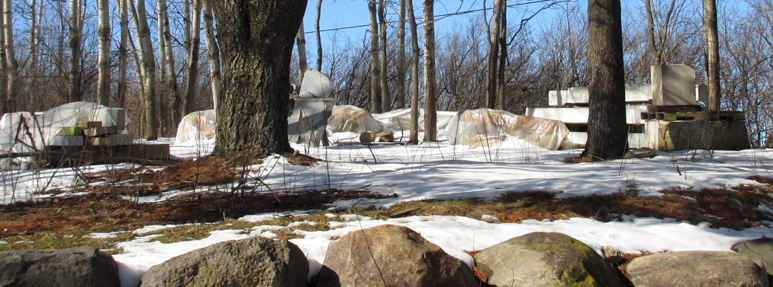
The Magic of Stone |
The earth has created itself into a cathedral of beautiful treasure stone — uncountable colors, shapes and textures, each piece stamped with its own rich family history. No wonder so many of us pick up stones that speak to us, and carry them home, placing them in special niches, and treating them as our own personal discoveries. Each offers a puzzling mystery to explore; each tweaks our imagination, stimulates our curiosity and raises interesting questions.
How did it end up right here where I found it? What is it made of? How was it created?
Was it originally formed by the process of settling? (Sedimentary — limestone, sandstone, travertine)
Or reformed from the original deposit, baked by pressure and heat? (Metamorphic — marble and crystal)
Or created by cooling molten lava escaping from the earth’s core? (Igneous — granite and basalt). The answers to our questions outline an array of qualities that author each stone’s unique personality.
The grace of a sculpture begins with the magic of the stone. That’s why I’ve filled my studio with about three lifetimes worth, still waiting to be carved. It’s the potential of each piece that brings me such joy! — Every carving block filled with beauty calling for attention; every stone an invitation for creative expression. Now that’s a good reason to get up every morning!
Here I’ll briefly highlight the magic qualities of those I use most often in my work as a sculptor. |
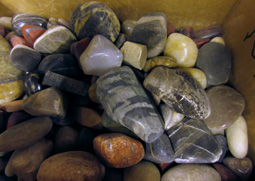
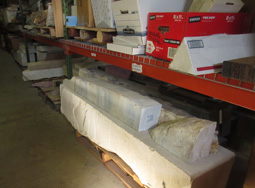 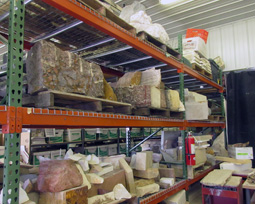
|
|
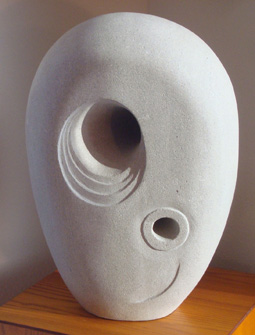 |
Limestone
Formed at sea bottom by the accumulation of calcium from settling shells, skeletons and plants, limestone solidifies — often still containing undigested fossils of its origin. Hardness varies from butter soft yellow (Texas Cream, Kansas Fencepost), eminently carveable and able to hold a good edge (Indiana Grey) and tighly brittle (Wisconsin Beige). Limestone is great to carve, but cannot be highly polished. It’s found almost everywhere and is durable, even in the North country’s weather. Look at small town buildings constructed 100 years ago and you will discover the type of limestone that lies nearby.
Left: Indiana Limestone |
|
Marble
When the sediment of limestone is covered and sealed by heavy overburden, the earth pressure-cooks it. Intense heat transforms the stone into a tight web of sparkly crystals, and compacts it into marble. Historically marble has been highly valued for its variety of colors (white, green, red, black) and its wonderful shine when polished. Sometimes it can be a bit tricky to carve, since the structural bedding plane (think the grain in wood) leaves the stone strong across the plane, but easily fractured in parallel with the plane. I most often carve Colorado Yule marble, and Carrara Italian marble but have plenty of variety on hand: Portuguese Pink, Norwegian Green, and several varieties from Vermont, Tennessee, Georgia and California. |
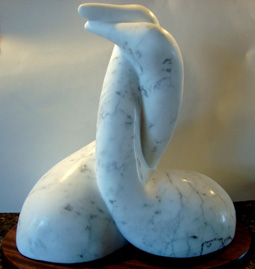
Carrara Marble
|
|
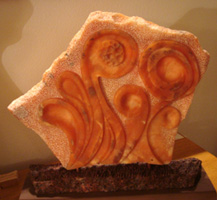
Utah Transcluscent Alabaster
|
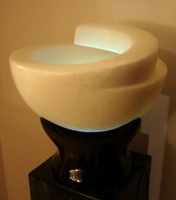
Translucent Italian Alabaster |
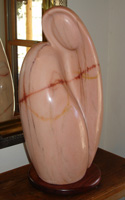
Portuquese
Marble |
| |
|
|

Utah Raspberry Alabaster |
Alabaster
A soft stone found in a grand palette of colors, alabaster is remarkably easy and so rewarding to carve and polish. It’s gypsum (think drywall) mixed with whatever minerals were nearby when it was being born. Formed by the evaporation of seawater, it retains the ability to soak up moisture so it must be protected from the sun and water. Found in long seams or chunks of various shapes, sometimes a piece of alabaster suggests what sculpture it wants to become. (Yes, sometimes it pays to listen as the stone speaks.) I love the translucent white Italian, the red and grey lines of Utah Raspberry, the translucent cream of the highly valued Utah Orange and the black/white variety from New Mexico. To check for fractures tap lightly with metal. If it sings, it’s solid. If cracked, it thunks. Not a good omen or a good sound. |
|
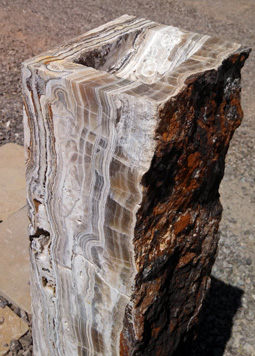
New Mexico Travertine |
Travertine
While normally not considered a true carving stone, travertine, especially New Mexico Travertine, has become one of my favorites. When mineral water bubbles out of the ground and flows away, the minerals are left behind (think Yellowstone National Park). Over centuries, these deposits grow into large hills of stone. Because the water runs willy-nilly, this way and that, and crosses over itself whenever it chooses, transporting and depositing whatever type and color of mineral it is carrying that year, travertine is complexly colored with random lines and swirls. Easily shaped, but carved at some risk since it tends to split along seams, travertine takes a great polish. For me every little chunk of this stone contains undeniable magic and the large blocks are mesmerizing. I’ve got a whole semi-load of it sitting around just for inspiration. |
|
Sandstone
In contrast to limestone which is calcium deposited on the sea floor, sandstone is silica deposited by wind on dry ground. As the windblown sand piles up into dunes, the increasing weight combined with iron and other minerals form the sand into a coarse stone. The differences in coloration produce lines and swirls that can be quite beautiful (think Utah Picture sandstone, or Navajo Red sandstone.) Silica is toxic when breathed. In addition, sand is an abrasive and while the stone is easy to cut, it quickly tears the diamonds off a good $200 blade. I have created several sandstone sculptures just for fun and variety, but prefer to use it only for bases and pedestals. |
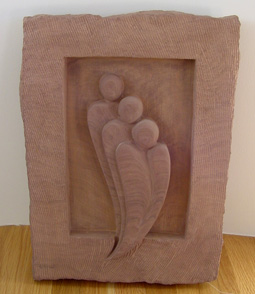
Navajo Sandstone
|
Granite
Granite, an igneous rock formed by lava, provides an amazing contradiction. On the one hand, it’s almost too hard to carve. One must pulverize the stone to shape it. On the other hand, it’s so hard and brittle that any strike force applied to the surface is carried straight through to the opposite side. In India, women with chisels sit tapping a straight line into a large block. In time the piece will split exactly as they intend. Many structures are built with 12 foot granite “2x4 studs.” The grit from grinding is toxic, so I mostly cut or split granite outside, and use it sparingly for bases. |
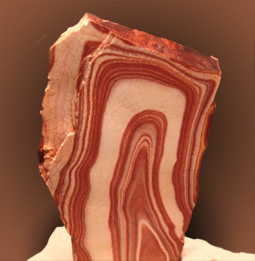
Utah Picture Sandstone
|
|

